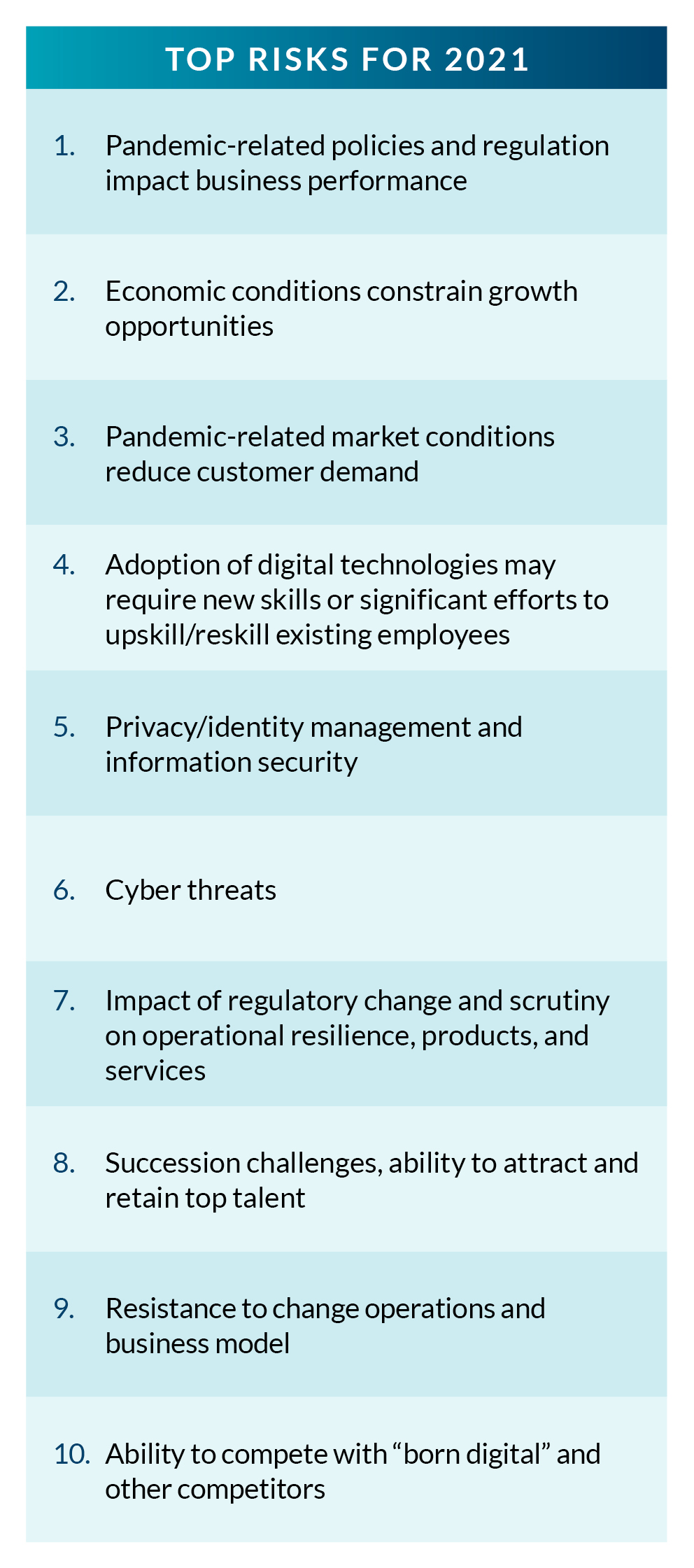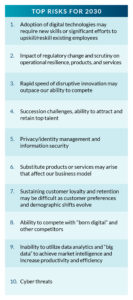In January, our 2021 Tech Priorities blog series highlighted just some of the topics that are top of mind for CIOs and CISOs this year. In our conversations with Protiviti leaders, we learned that, in addition to being drivers of the tools that will keep their organizations’ secure, drive innovation, improve customer experience and drive revenue growth, these leaders are also faced with a resource challenge: getting and keeping the right people onboard. These conclusions were also supported in the results of Protiviti’s Executive Perspectives on Top Risks in 2021 and 2030.
In this survey, C-level executives from around the world ranked “adoption of new digital technologies may require new skills or significant efforts to upskill/reskill existing employees” as the fourth most important concern, while “succession challenges, ability to attract and retain top talent” ranked eighth. By 2030, those two issues jump to the first and fourth positions, respectively, a clear sign that people power will be critical to organizations well into the future.

Tech is a hot labor market now and promises to remain so for many years to come. Demand outpaces availability, so much so that, “by the time you know you need a certain type of skill, it’s almost too late,” according to Kim Bozzella, managing director who leads Protiviti’s technology strategy and operations practice.

“Both cyber skills and core technical skills are in demand everywhere,” she said, adding “the need to have resources who are able to hit the ground running with newer technologies while also keeping the skills needed to maintain older systems, is a balancing act for many technology leaders.”
“Curious and Creative”
Technology teams are critical to any organization’s success. But they can be considered a unique animal. And it’s up to the leadership to ensure their employees find their work to be challenging and rewarding. Building an innovation culture, where everyone on the team can learn and grow, is one way to ensure employees want to stay, rather than being poached by a better offer. Bozzella explained, “Keeping the really good people onboard is going to be harder than ever. 2020 showed us that, with boundaries coming down and people being able to work remotely, CIOs gained a lot of flexibility, employees did as well. Now, they no longer have to work close to where they live, so it opens up a world of career opportunities.”
Technology leaders need to focus on their core business while also enabling innovation, according to Bozzella. “With the change brought about by innovation and evolving technologies, the workforce has to change as well,” she said. To drive innovation, “leaders need to recognize individuals or teams that are curious and creative and pivot them to roles where that mindset will thrive. Allow them to ask the questions, get feedback and talk to their customers, talk to their business stakeholders. Drive that approach throughout the organization. A CIO that can look at all of these pieces together will be a differentiator.”
 Building a future ready workforce, adapting the people of the organization to be ready for new tools, is “a pretty important part” of technology leadership, Bozzella said. She encourages leaders to consider how the people who have supported older technologies will be impacted when new are introduced. “Some of these people have incredible amounts of domain and institutional knowledge,” she said. “Good leaders don’t want to lose those resources – they want to retain them. But they need to invest in re-skilling.” Anticipating the training and change management needs of that workforce in advance of bringing the new technology onboard creates an environment where people want to play a valuable role. “They are continuing to develop and build their skills and they’re engaged in the work. That’s a real culture of innovation,” she added.
Building a future ready workforce, adapting the people of the organization to be ready for new tools, is “a pretty important part” of technology leadership, Bozzella said. She encourages leaders to consider how the people who have supported older technologies will be impacted when new are introduced. “Some of these people have incredible amounts of domain and institutional knowledge,” she said. “Good leaders don’t want to lose those resources – they want to retain them. But they need to invest in re-skilling.” Anticipating the training and change management needs of that workforce in advance of bringing the new technology onboard creates an environment where people want to play a valuable role. “They are continuing to develop and build their skills and they’re engaged in the work. That’s a real culture of innovation,” she added.
Technology Builds Employee Engagement

Greg George, associate director and customer experience expert, echoes Bozzella’s call for employee engagement to build a high-performing organization. “We have found that employee engagement is just as critical as the customer experience itself,” he said. “Employees are representative of the company’s brand. They are the ones directly connecting with the customer, so they need to feel they are an important part of that process.”
Here’s where companies can use technology to improve engagement. He cited call centers, which often experience high agent turnover, as an example. “Call center employees often are not engaged with their organizations and they’re really not involved with the customer experience process. They’re doing rote tasks, answering the same questions over and over, with little opportunity to feel like they’re really making a difference.” Introducing a technology like artificial intelligence (AI), where the company consolidates its data lake and creates an infrastructure where AI identifies basic issues for the customer, routes the caller to knowledge bases or FAQs to answer the simple questions. “Then, AI can predict what the customer’s next questions will be, based on past issue resolution. By the time the call reaches the agent, they can more impactfully interact with the customer, based on the information AI has predicted and provided.”
Centralizing data in the cloud achieves multiple outcomes for the organization. “It allows for seamless cross-channel analytics to provide KPIs that are balanced across the organization. This breaks down those organizational silos, providing a clear picture of the customer interactions across all those channels, allowing the company to set goals that are focused on the customer and not the organization,” George said. If data is centralized, agents can use a single workspace for all the channels when working with the customer. This improves the employee experience as well as the customer experience. Finally, business can leverage artificial intelligence once that data lake is set. “This, in turn, takes the burden off those agents to provide those repetitive tasks and allows them to focus on those level three, level four issues that are much more satisfying,” he added.
New Skills, New Roles
Another important concern for technology leaders is to develop the right roles to handle the evolving technologies. Just one example of that, said George, is the concept of a knowledge manager. “AI is great, but you have to have the tech staff in place to be able to make the most of AI, machine learning – which requires machine teaching – and all the other yet-to-be-discovered new tools.” Many companies are now moving to hire knowledge managers, who, George said, “evaluate data patterns and trends and identify which ones are actionable for the business.” These managers also manage the information lifecycle, adjusting as the needs of the business evolve and grow.

Leslie Howatt, a managing director from Protiviti Australia, is a former CIO and likens the role technology leaders play in developing a highly skilled team to mountain climbing. “I did a little bit of mountain climbing in Russia and Nepal years ago. The great mountain guides spend every day assessing risks and adjusting plans to keep their group safe and healthy under ever-changing conditions, while always staying focused on the goal of reaching the summit. It’s that kind of intuitive, continuous focus on the team that tech leaders need – to get all of your climbers safely to the summit (and back) with you.”
To learn more, visit our website or contact us.





